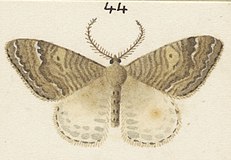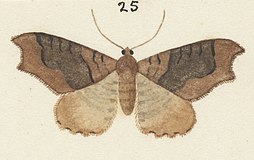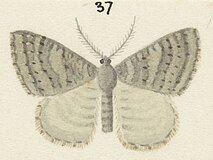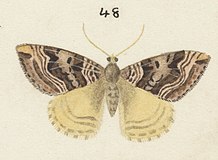File:MA I437612 TePapa Plate-XIII-The-butterflies full.jpg

Original file (8,402 × 10,568 pixels, file size: 16.51 MB, MIME type: image/jpeg)
Captions
Captions
Summary edit
| Warning | The original file is very high-resolution. It might not load properly or could cause your browser to freeze when opened at full size. |
|---|
| George Vernon Hudson: Plate XIII. The butterflies and moths of New Zealand.
( |
|||||||||||||||||||||
|---|---|---|---|---|---|---|---|---|---|---|---|---|---|---|---|---|---|---|---|---|---|
| Artist |
artist QS:P170,Q2064874 |
||||||||||||||||||||
| Title |
Plate XIII. The butterflies and moths of New Zealand. |
||||||||||||||||||||
| Description |
English: Watercolour by George Hudson. Plate XIII. The butterflies and moths of New Zealand.
|
||||||||||||||||||||
| Date |
circa 1927 date QS:P571,+1927-00-00T00:00:00Z/9,P1480,Q5727902 |
||||||||||||||||||||
| Medium |
watercolor on paper medium QS:P186,Q22915256;P186,Q11472,P518,Q861259 |
||||||||||||||||||||
| Dimensions |
height: 31.6 cm (12.4 in); width: 25.4 cm (10 in) dimensions QS:P2048,31.6U174728 dimensions QS:P2049,25.4U174728 |
||||||||||||||||||||
| Collection |
institution QS:P195,Q915603 |
||||||||||||||||||||
| Accession number |
1992-0035-2304 |
||||||||||||||||||||
| Source/Photographer | https://collections.tepapa.govt.nz/object/1129122 | ||||||||||||||||||||
| Permission (Reusing this file) |
No Known Copyright Restrictions | ||||||||||||||||||||
| Other versions | |||||||||||||||||||||
Licensing edit
| Public domainPublic domainfalsefalse |
|
This work is in the public domain in its country of origin and other countries and areas where the copyright term is the author's life plus 70 years or fewer.
| |
| This file has been identified as being free of known restrictions under copyright law, including all related and neighboring rights. | |
https://creativecommons.org/publicdomain/mark/1.0/PDMCreative Commons Public Domain Mark 1.0falsefalse
| Public domainPublic domainfalsefalse |
This New Zealand work is in the public domain in New Zealand, because its copyright has expired or it is not subject to copyright (details). According to the New Zealand Copyright Act of 1994 as elaborated on by the Standing Committee on Copyright of the Library and Information Association of New Zealand (LIANZA), as of May 2011:
1 Some government publications are not subject to copyright, including bills, acts, regulations, court judgments, royal commission and select committee reports, etc. See references [1] or [2] for the full list.
|
|||||||||||||||||||||||
File history
Click on a date/time to view the file as it appeared at that time.
| Date/Time | Thumbnail | Dimensions | User | Comment | |
|---|---|---|---|---|---|
| current | 02:49, 25 September 2018 |  | 8,402 × 10,568 (16.51 MB) | Ambrosia10 (talk | contribs) | pattypan 18.02 |
You cannot overwrite this file.
File usage on Commons
The following 52 pages use this file:
- User:DCB/Landkreis Görlitz/2018 September 21-30
- File:Fig 10 MA I437612 TePapa Plate-XIII-The-butterflies full (cropped).jpg
- File:Fig 11 MA I437612 TePapa Plate-XIII-The-butterflies full (cropped).jpg
- File:Fig 12 MA I437612 TePapa Plate-XIII-The-butterflies full (cropped).jpg
- File:Fig 13 MA I437612 TePapa Plate-XIII-The-butterflies full (cropped).jpg
- File:Fig 14 MA I437612 TePapa Plate-XIII-The-butterflies full (cropped).jpg
- File:Fig 15 MA I437612 TePapa Plate-XIII-The-butterflies full (cropped).jpg
- File:Fig 16 MA I437612 TePapa Plate-XIII-The-butterflies full (cropped).jpg
- File:Fig 17 MA I437612 TePapa Plate-XIII-The-butterflies full (cropped).jpg
- File:Fig 18 MA I437612 TePapa Plate-XIII-The-butterflies full (cropped).jpg
- File:Fig 19 MA I437612 TePapa Plate-XIII-The-butterflies full (cropped).jpg
- File:Fig 1 MA I437612 TePapa Plate-XIII-The-butterflies full (cropped).jpg
- File:Fig 20 MA I437612 TePapa Plate-XIII-The-butterflies full (cropped).jpg
- File:Fig 21 MA I437612 TePapa Plate-XIII-The-butterflies full (cropped).jpg
- File:Fig 22 MA I437612 TePapa Plate-XIII-The-butterflies full (cropped).jpg
- File:Fig 23 MA I437612 TePapa Plate-XIII-The-butterflies full (cropped).jpg
- File:Fig 24 MA I437612 TePapa Plate-XIII-The-butterflies full (cropped).jpg
- File:Fig 25 MA I437612 TePapa Plate-XIII-The-butterflies full (cropped).jpg
- File:Fig 26 MA I437612 TePapa Plate-XIII-The-butterflies full (cropped).jpg
- File:Fig 27 MA I437612 TePapa Plate-XIII-The-butterflies full (cropped).jpg
- File:Fig 28 MA I437612 TePapa Plate-XIII-The-butterflies full (cropped).jpg
- File:Fig 29 MA I437612 TePapa Plate-XIII-The-butterflies full (cropped).jpg
- File:Fig 2 MA I437612 TePapa Plate-XIII-The-butterflies full (cropped).jpg
- File:Fig 30 MA I437612 TePapa Plate-XIII-The-butterflies full (cropped).jpg
- File:Fig 31 MA I437612 TePapa Plate-XIII-The-butterflies full (cropped).jpg
- File:Fig 32 MA I437612 TePapa Plate-XIII-The-butterflies full (cropped).jpg
- File:Fig 33 MA I437612 TePapa Plate-XIII-The-butterflies full (cropped).jpg
- File:Fig 34 MA I437612 TePapa Plate-XIII-The-butterflies full (cropped).jpg
- File:Fig 35 MA I437612 TePapa Plate-XIII-The-butterflies full (cropped).jpg
- File:Fig 36 MA I437612 TePapa Plate-XIII-The-butterflies full (cropped).jpg
- File:Fig 37 MA I437612 TePapa Plate-XIII-The-butterflies full (cropped).jpg
- File:Fig 38 MA I437612 TePapa Plate-XIII-The-butterflies full (cropped).jpg
- File:Fig 39 MA I437612 TePapa Plate-XIII-The-butterflies full (cropped).jpg
- File:Fig 3 MA I437612 TePapa Plate-XIII-The-butterflies full (cropped).jpg
- File:Fig 40 MA I437612 TePapa Plate-XIII-The-butterflies full (cropped).jpg
- File:Fig 41 MA I437612 TePapa Plate-XIII-The-butterflies full (cropped).jpg
- File:Fig 42 MA I437612 TePapa Plate-XIII-The-butterflies full (cropped).jpg
- File:Fig 43 MA I437612 TePapa Plate-XIII-The-butterflies full (cropped).jpg
- File:Fig 44 MA I437612 TePapa Plate-XIII-The-butterflies full (cropped).jpg
- File:Fig 45 MA I437612 TePapa Plate-XIII-The-butterflies full (cropped).jpg
- File:Fig 46 MA I437612 TePapa Plate-XIII-The-butterflies full (cropped).jpg
- File:Fig 47 MA I437612 TePapa Plate-XIII-The-butterflies full (cropped).jpg
- File:Fig 48 MA I437612 TePapa Plate-XIII-The-butterflies full (cropped).jpg
- File:Fig 49 MA I437612 TePapa Plate-XIII-The-butterflies full (cropped).jpg
- File:Fig 4 MA I437612 TePapa Plate-XIII-The-butterflies full (cropped).jpg
- File:Fig 50 MA I437612 TePapa Plate-XIII-The-butterflies full (cropped).jpg
- File:Fig 5 MA I437612 TePapa Plate-XIII-The-butterflies full (cropped).jpg
- File:Fig 6 MA I437612 TePapa Plate-XIII-The-butterflies full (cropped).jpg
- File:Fig 7 MA I437612 TePapa Plate-XIII-The-butterflies full (cropped).jpg
- File:Fig 8 MA I437612 TePapa Plate-XIII-The-butterflies full (cropped).jpg
- File:Fig 9 MA I437612 TePapa Plate-XIII-The-butterflies full (cropped).jpg
- File:MA I437612 TePapa Plate-XIII-The-butterflies full.jpg




















































